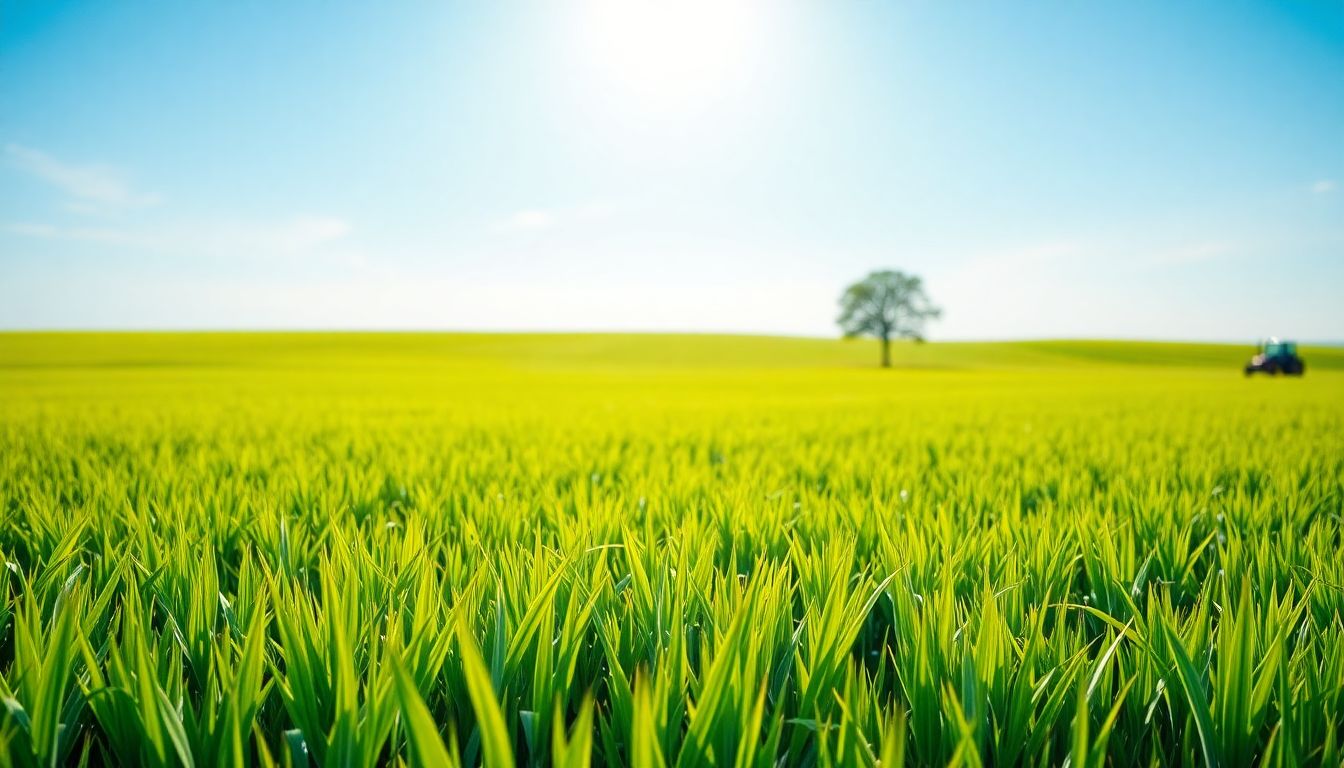Many farmers struggle to predict how well their crops will grow, which makes planning tricky and can lead to wasted resources or lost harvests. The good news is that AI can turn mountains of data into reliable forecasts, helping farmers make smarter decisions early on. If you’re curious about how this works and how it’s changing farming, keep reading—you might find the solution you’ve been looking for.
In this quick overview, you’ll see how AI uses things like satellite images, weather info, and sensors to predict crop yields more accurately than ever before. We’ll also look at real-world results and how this technology saves water, cuts costs, and boosts productivity—benefits that farmers and supply chains are already enjoying.
Key Takeaways
Key Takeaways
- AI can predict crop yields with over 90% accuracy by analyzing data like weather, soil, and satellite images. This helps farmers plan better, avoid waste, and increase profits. Real-world results show water savings and yield boosts, proving AI’s usefulness in farming.
- Key tools include satellite technology, soil sensors, and weather data, all feeding into AI algorithms like decision trees and neural networks. Using these together makes predicting yields more reliable and accessible for farmers.
- Farmers around the world already see benefits such as reducing water use, lowering fertilizer costs, and increasing harvests. AI helps make farming more efficient, sustainable, and capable of feeding more people.
- AI improves planting, irrigation, and harvesting schedules by analyzing weather and soil conditions, leading to better yields and resource use. It also alerts farmers to sudden changes, helping them adapt quickly.
- Using AI supports sustainable farming by reducing water, fertilizer, and emissions. It helps small farmers grow more while protecting the environment, contributing to food security.
- Challenges include high costs for equipment, data quality issues, and the need for farmer training. Despite this, community programs and affordable tech are making AI more accessible.
- The future of AI in farming looks bright—more integrated data, smarter models, and autonomous machinery will make farming more precise and resource-efficient, benefiting all farm sizes.
- Many small to medium farms now use AI tools thanks to lower costs and easier platforms. This broad use helps build a resilient food system worldwide, no matter the farm size.
- Start small by exploring existing AI platforms and using your farm data. Experiment on a small scale to see how predictions match reality and learn as you go.
- Choose AI tools that fit your farm’s size and budget, prioritize ease of use, and ensure they provide clear insights. Support and tutorials help in making the most of these platforms.
- When using AI marketplaces, verify seller identities, read reviews, and use escrow to protect your investments. Start with small projects to build trust before bigger commitments.
- AI crop prediction will keep improving as sensors and computing power advance. Early adopters will enjoy better yields, lower costs, and a stronger farm for the future.

Step 1: Understand the Role of AI in Crop Yield Prediction
When it comes to farming, knowing how much you’ll harvest before you even plant might sound like a superpower, but AI makes it possible. It predicts crop yields by crunching huge amounts of data—from weather patterns to soil health—using smart algorithms. This early insight is gold for farmers and supply chains because it helps them plan, buy resources, and manage risks better. Unlike traditional guesswork, AI models can hit over 90% accuracy, giving farmers a clear picture of what to expect. For example, in the U.S. Midwest, AI-driven models for wheat and corn have helped boost yields by over 15%, proving just how vital accurate predictions are for food security and economic stability.
Step 2: Know the Key Technologies Behind AI Crop Yield Prediction
Predicting yields with AI relies on a mix of tech tools and data sources. Satellite images and drones capture detailed images of crop health, while soil sensors monitor moisture and nutrients in real time. Weather data—like temperature, rainfall, and humidity—adds context to how crops grow. All this information feeds into advanced AI algorithms such as neural networks and decision trees, which learn from past patterns to make accurate forecasts. Many platforms—like cloud-based services or specialized AI tools—bring these pieces together, making it easier for farmers and developers to access and work with these powerful models.
Step 3: Recognize the Real-World Results of AI in Agriculture
If you think AI is just fancy tech talk, think again. Farms worldwide are already seeing tangible benefits. In Punjab, India, rice farmers reduced water usage by 20% while increasing yields by 18% thanks to drone surveillance and AI analysis. In Brazil, soybean growers increased yields by 10% and cut fertilizer costs by 12% because AI helped monitor crop health more precisely. Plus, in the U.S., AI models achieved over 92% accuracy in predicting yields, leading to better planning and fewer surprises. These real examples show that AI isn’t just predicting; it’s actively helping farmers grow more food, save resources, and cut costs.

Step 4.1: How AI Optimizes Planting, Irrigation, and Harvesting Schedules
One of the biggest wins with AI is its ability to help farmers decide the best times to plant, water, and harvest crops.
By analyzing weather forecasts, soil moisture levels, and crop growth data, AI models can suggest optimal schedules that maximize yields and minimize resource use.
For example, AI-powered tools can tell you when soil conditions are ideal for planting, saving you from guesswork or accidental overwatering.
This means fewer wasted inputs and more consistent harvests, especially in areas where weather can be unpredictable.
Some platforms even send alerts if conditions suddenly change, helping you adapt quickly and avoid losses.
Step 4.2: How AI Enhances Food Security and Sustainable Agriculture
Using AI to improve crop management isn’t just good for your farm—it’s a step toward keeping food supplies stable and reducing environmental impact.
Targeted planting and irrigation reduce excess water usage, while precise nutrient management cuts down on fertilizer runoff.
This approach not only saves resources but also helps in lowering greenhouse gas emissions linked to farming activities.
For smallholder farmers, affordable AI-based solutions can boost productivity and resilience against climate stress.
In the long run, more efficient farming means more food to feed a growing world population without depleting natural resources.
Step 5.1: What Are the Main Challenges Facing AI in Farming Today?
While AI in agriculture has come a long way, it still faces hurdles that slow adoption in some areas.
High upfront costs for equipment, sensors, and software can be intimidating for small farmers or those in developing countries.
Data quality and consistency are another issue—garbage in, garbage out, as they say—meaning bad data leads to unreliable predictions.
There’s also a need for farmers to learn how to use these tech tools effectively, which may require training and ongoing support.
Despite these obstacles, solutions like subsidized equipment and community training programs are starting to make a difference.
Step 5.2: What Are Some Trends Shaping the Future of AI in Agriculture?
Looking ahead, AI systems are getting smarter and more autonomous, promising less manual input from farmers.
We can expect more integration of data streams, like combining satellite, drone, and soil sensor info into one neat package.
Models will become better at predicting not only yields but also potential pest outbreaks or disease risks, helping farmers act proactively.
AI-powered robots and machinery are also on the rise, taking over repetitive tasks like planting or spraying fertilization.
And as more farms adopt these tools, expect a steady shift toward even more precise, resource-efficient farming practices.
Step 5.3: Which Types of Farms Are Embracing AI Predictions?
AI crop prediction isn’t just for big industrial farms anymore—small and medium-sized farms are jumping on board too.
Thanks to lower costs and user-friendly platforms, even smallholders in regions like Africa and Southeast Asia are benefiting from tailored recommendations.
Large-scale commercial farms are leveraging AI to optimize entire supply chains, from planting schedules to logistics.
This broad adoption helps create a more resilient food system worldwide, no matter the farm’s size.
In the end, AI’s scalability makes it a valuable tool for every farmer aiming to grow more with less.
Step 6.1: How to Get Started with AI Crop Yield Prediction for Your Farm
If you’re interested in bringing AI into your field, start small by exploring existing platforms—like sellaitool.com—which connect farmers with AI tools and developers.
Gather data sources you already have—like weather records or soil test results—and see what kind of insights they can generate.
Look for easy-to-use software that offers tutorials or support—you don’t need a PhD in AI to benefit from these tools.
Start with a pilot project, maybe focusing on a single crop or field, to see how AI predictions line up with your outcomes.
Remember, implementing AI is a learning process—patience and incremental steps pay off in the long run.
Step 6.2: Tips for Choosing the Right AI Tools and Platforms
Pick tools that match your farm size, crop type, and budget—don’t get swayed by fancy features you won’t use.
Check if the platform uses trusted algorithms like Random Forest or LightGBM Regressor, which have shown prediction accuracies exceeding 90% in studies [1][3].
Ensure the data input process is straightforward; complex setups can discourage ongoing use.
Look for platforms offering support, whether through tutorials, customer service, or community forums.
Finally, choose a solution that provides clear, actionable insights—not just data dumps—so you can make informed decisions without extra fuss.
Step 6.3: How to Ensure Secure and Reliable Transactions on AI Marketplaces
When trading or collaborating via platforms like sellaitool.com, security should be a top priority.
Look for websites that verify seller and buyer identities, to prevent scams or fake data.
Use platform escrow services—these hold payments until you confirm the quality of work or data—so you’re protected.
Always review seller ratings and past transaction feedback to gauge trustworthiness.
And when in doubt, start with smaller projects to build confidence before committing to big deals.
Step 7: Why AI Crop Yield Prediction Will Keep Gaining Momentum
As farms become more data-rich and tech-savvy, AI predictions are here to stay—and will only get better.
With continuous improvements in sensors, cloud computing, and machine learning models, accuracy rates are likely to stay above 90%, making decision-making easier.
The push for sustainable farming aligns well with AI, as resource-efficient practices become more critical globally.
Farmers who adopt AI early tend to see better yields, lower costs, and less waste, giving them a competitive edge.
In short, embracing AI in agriculture is a smart move that supports both business success and the planet’s health.
FAQs
AI analyzes data from satellites, weather, and soil sensors to forecast crop yields. It identifies patterns and provides early, accurate predictions that help farmers plan and optimize resources effectively.
Key technologies include satellite imaging, weather data, soil sensors, drones, neural networks, decision trees, and cloud platforms that process and analyze agricultural data effectively.
AI helps improve yield accuracy, reduces water and input costs, supports pest and weather management, and enhances overall farm productivity for growers and supply chains.
Main challenges include high setup costs, data quality issues, and the need for farmer training to effectively use AI tools in decision-making processes.